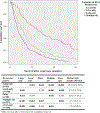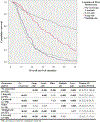Implications of the Pattern of Disease Recurrence on Survival Following Pancreatectomy for Pancreatic Ductal Adenocarcinoma
- PMID: 29948425
- PMCID: PMC6220676
- DOI: 10.1245/s10434-018-6558-7
Implications of the Pattern of Disease Recurrence on Survival Following Pancreatectomy for Pancreatic Ductal Adenocarcinoma
Abstract
Background: After radical resection of pancreatic ductal adenocarcinoma (PDAC), approximately 80% of patients will develop disease recurrence. It remains unclear to what extent the location of recurrence carries prognostic significance. Additionally, stratifying the pattern of recurrence may lead to a deeper understanding of the heterogeneous biological behavior of PDAC.
Objective: The aim of this study was to characterize the relationship of recurrence patterns with survival in patients with resected PDAC.
Methods: This single-center cohort study included patients undergoing pancreatectomy at the Johns Hopkins Hospital between 2000 and 2013. Exclusion criteria were neoadjuvant therapy and incomplete follow-up. Sites of first recurrence were stratified into five groups and survival outcomes were estimated using Kaplan-Meier curves. The association of specific recurrence locations with overall survival (OS) was analyzed using Cox proportional-hazards models with and without landmark analysis.
Results: Accurate follow-up data were available for 877 patients, 662 (75.5%) of whom had documented recurrence at last follow-up. Patients with multiple-site (n = 227, 4.7 months) or liver-only recurrence (n = 166, 7.2 months) had significantly worse median survival after recurrence when compared with lung- (n = 93) or local-only (n = 158) recurrence (15.4 and 9.7 months, respectively). On multivariable analysis, the unique recurrence patterns had variable predictive values for OS. Landmark analyses, with landmarks set at 12, 18, and 24 months, confirmed these findings.
Conclusions: This study demonstrates that specific patterns of PDAC recurrence result in different survival outcomes. Furthermore, distinct first recurrence locations have unique independent predictive values for OS, which could help with prognostic stratification and decisions regarding treatment after the diagnosis of recurrence.
Conflict of interest statement
Figures


Comment in
-
ASO Author Reflections: Do Distinct Patterns of Recurrence Impact the Prognosis of Patients With Resected Pancreatic Ductal Adenocarcinoma?Ann Surg Oncol. 2018 Dec;25(Suppl 3):806-807. doi: 10.1245/s10434-018-6820-z. Epub 2018 Oct 8. Ann Surg Oncol. 2018. PMID: 30298312 No abstract available.
References
-
- Rahib L, Smith BD, Aizenberg R, Rosenzweig AB, Fleshman JM, Matrisian LM. Projecting cancer incidence and deaths to 2030: the unexpected burden of thyroid, liver, and pancreas cancers in the United States. Cancer Res. 2014;74:2913–21. - PubMed
-
- Riall TS, Cameron JL, Lillemoe KD, Winter JM, Campbell KA,Hruban RH, et al. Resected periampullary adenocarcinoma: 5-year survivors and their 6- to 10-year follow-up. Surgery. 2006;140:764–72. - PubMed
-
- Cameron JL, He J. Two thousand consecutive pancreaticoduodenectomies. J Am Coll Surg. 2015;220:530–6. - PubMed
-
- Sperti C, Pasquali C, Piccoli A, Pedrazzoli S. Recurrence afterresection for ductal adenocarcinoma of the pancreas. World J Surg. 1997;21:195–200. - PubMed
MeSH terms
Grants and funding
LinkOut - more resources
Full Text Sources
Other Literature Sources
Medical

